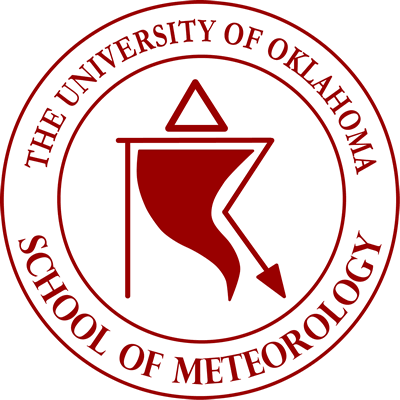Nichés dans l'école de météorologie de l'Université de l'Oklahoma, divers étudiants travaillent assidûment avec Baron Lynx™, reconstituant leurs histoires météorologiques pour de multiples projets. Le département compte une centaine d'étudiants à tout moment, dont une quarantaine obtiennent leur diplôme chaque année.

Shawn Riley, spécialiste des données de recherche à l'école de météorologie, surveille ses étudiants qui utilisent le poste de travail de prévision tout en réfléchissant au passé.
L'université n'est pas étrangère aux produits de prévision de Baron. Elle a utilisé les anciens produits Viper et Omni et a commencé à utiliser Lynx - qui combine les graphiques météorologiques, l'analyse météorologique et le suivi des tempêtes en une seule plateforme - il y a sept ans.
Lynx a été développé avec l'aide de plus de 70 professionnels de la radiodiffusion, dont des météorologues et des directeurs de l'information. Lynx a reçu des critiques élogieuses lors de sa sortie en 2016, car il a permis aux météorologues de communiquer des histoires météorologiques captivantes et de dominer les moments qui définissent la station. Les chaînes de télévision ont apprécié le fait que Lynx leur offrait une architecture évolutive qu'elles pouvaient configurer en fonction de leurs besoins.
Bien que l'université ait également utilisé d'autres logiciels de prévision, Lynx reste le statu quo.
Adopteurs précoces
Selon Riley, les étudiants ont accès à Lynx dès le début. Il propose également un cours d'un crédit sur Baron que la plupart des étudiants suivent en deuxième année.
"Dès qu'ils entrent, ils peuvent accéder à la machine", ajoute-t-il. "Ils peuvent commencer à expérimenter et à travailler sur des sujets météorologiques qui peuvent être diffusés dans les studios du National Weather Center et du Gaylord College of Journalism and Mass Communications.

Selon M. Riley, les étudiants adoptent rapidement les capacités offertes par Lynx. "Les étudiants aiment travailler avec Lynx. Ils ne trouvent pas cela trop difficile. Nous avons récemment commencé à faire des reportages de longue durée en utilisant Lynx en studio et en ligne.
À partir de quel moment sont-ils des connaisseurs ? Ou peut-être même des superutilisateurs ?
"Certains étudiants s'y mettent plus vite que d'autres, mais pour la plupart, au semestre de printemps de leur première année, la plupart d'entre eux sont assez bien formés", note M. Riley.
Lynx, utilisé pour l'analyse et l'affichage des données météorologiques ainsi que pour les prévisions, permet aux étudiants en météorologie de publier leurs prévisions, les rendant ainsi visibles pour les personnes extérieures à la salle de classe. Cette technologie permet aux étudiants d'affiner leur expertise professionnelle et de se faire un nom avant l'obtention de leur diplôme.
"J'ai des étudiants qui sont sur le point de commencer leur première année et qui travaillent déjà en freelance et sur le marché. Pour quelqu'un qui est sur le point de commencer sa première année en météorologie, ce n'est pas négligeable", déclare M. Riley.
Les anciens élèves qui reviennent, en particulier ceux qui sont partis depuis plusieurs années, sont ravis de voir les étudiants utiliser Baron Lynx.
Étudiants en météorologie de l'Université de l'Oklahoma : Des conteurs pleins d'aplomb
"Beaucoup d'anciens élèves utilisent actuellement Baron ou un concurrent. Ils n'en reviennent pas. Avant 2010, les étudiants utilisaient Photoshop et PowerPoint pour le programme d'information de l'université, OU Nightly.
Lorsque les anciens élèves voient ce que les étudiants font aujourd'hui et ce qu'ils mettent en place, ils sont complètement époustouflés. Les étudiants utilisent aujourd'hui des technologies que les anciens élèves utilisent quotidiennement dans leur carrière".
-- Shawn Riley Spécialiste des données de recherche, École de météorologie de l'Université de l'Oklahoma
Le département de météorologie se targue d'un taux de placement de 100 %. Riley ajoute que Lynx joue un rôle important dans ce succès pour plusieurs raisons. Il attribue à Lynx le mérite d'avoir aidé ses étudiants à devenir plus polyvalents. Ils apprennent également à affiner leurs compétences en matière de narration. Lynx permet aux étudiants d'intégrer d'autres données météorologiques disponibles et de créer des graphiques parfaitement adaptés à l'environnement de la classe.
"Cela peut paraître bizarre, mais l'une des choses les plus précieuses se produit lorsque les étudiants montent leur spectacle", explique Riley. "Lynx les amène à réfléchir à l'histoire qu'ils racontent. Le fait de les mettre en présence d'un système graphique complet les aide à se concentrer sur la structuration de leur contenu et sur la manière dont ils veulent raconter cette histoire.
Riley a des conseils à donner aux autres universités qui envisagent de faire appel à Lynx.
"Si les étudiants s'intéressent à la production, à la diffusion ou à la communication météorologique et que l'université dispose des fonds nécessaires, c'est une évidence. La quantité de compétences que Lynx apporte aux étudiants pour qu'ils réussissent lorsqu'ils seront diplômés en vaut largement la peine. L'expertise de Lynx est très utile lorsque les étudiants obtiennent leur diplôme. Ils peuvent alors trouver des emplois sur des marchés plus importants comme la Nouvelle-Orléans et Saint-Louis".
-- Shawn Riley
"Si l'université dispose des ressources nécessaires mais n'utilise pas Lynx, elle ne rend pas service aux étudiants. C'est une évidence."
Si vous êtes à la recherche d'une solution météorologique personnalisée qui vous convienne, discutons de vos besoins.
